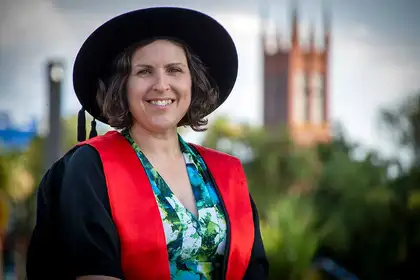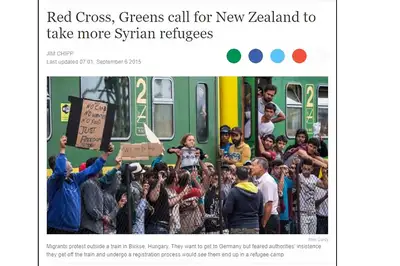
Dr Natalie Slade, who graduated with a PhD in Development Studies for her research on representations of refugees in the media.
Heart-wrenching images of desperate refugees may evoke empathy and compassion in host nations where those displaced by war and disaster re-settle. But new research reveals how the “refugee” label can interfere with the wish for a new life.
Dr Natalie Slade, who graduated last week with a PhD in Development Studies, turned her photojournalism background into a lens for understanding the way refugees are represented in the media and in advocacy campaigns, and how this can affect a sense of identity and belonging for resettled refugees.
She says the typical media portrayal of refugees as victims who are impoverished, desperate and suffering is part of their story, and is what arouses concern, sympathy and a willingness to help on the part of nations that resettle refugees.
But there is a paradox at play, because these kinds of images can create stereotypes about refugees while reinforcing a self-congratulatory altruism on the part of the host country. This can make it difficult for former refugees to carve out a new life and identity beyond the association with the traumatic circumstances that brought them here.
“Although discourses of solidarity and welcome stem from humanitarian concern, they also risk encouraging a regime of compassion and charity that speaks more about ourselves and how we feel,” she says.
Former refugees she spoke to say stereotypes produced by advocacy based on being victims can be stigmatising. “People [in host nations] seem surprised to learn they [refugees] are educated, had a good job and could afford to live well.”
She says that people who flee war and terror may be vulnerable, but this doesn’t mean they have nothing, or came from nothing. “The normal image of a refugee is someone who is poor and destitute. Therefore, if refugees are pictured with a smart phone, and they dress nicely, then somehow people think they’re not ‘real’ refugees or don’t deserve to be a refugee.
Dr Slade, whose thesis is titled: (De)constructing ‘refugeeness’: Exploring mediated discourses of solidarity, welcome and refugee (self)representation in New Zealand, says that while advocacy campaigns rely on public support, they can also simplify who refugees are.

The refugee crisis in Europe in 2015, and the New Zealand response to it, was the catalyst for Dr Slade's doctoral research.
When are you no longer a refugee?
When a refugee arrives in the resettlement programme in New Zealand they are technically and legally no longer a refugee, and become permanent residents.
Former refugees she spoke to saw themselves as being New Zealanders. Not all felt the refugee label was negative while others rejected it because they felt it diminished them as a person. “It’s not so much a problem in terms of how they saw themselves, but how they think the New Zealand public sees them.
Dr Slade’s interest in the topic was sparked by a particular photo viewed globally in 2015 – that of drowned toddler Alan Kurdi, whose body washed up on a beach in Turkey after the boat he and his family were in capsized trying to reach Europe. “Although thousands of refugees had already lost their lives trying to cross the Mediterranean in search of safety, Alan’s photo evoked feelings of outrage and sadness, becoming the defining image of the so-called European refugee crisis,” she writes in her thesis. “Unlike other photos of the crisis, Alan’s photo created a groundswell of public support around the world for those seeking refuge.”
She was interested in the impact of this photo, from the citizens across Europe who mobilised into action under the banner of ‘Refugees Welcome’, to New Zealand where the 2015 refugee crisis sparked a media/public campaign urging the National government to raise the quota and welcome more refugees into New Zealand. Over 1000 refugees come to New Zealand annually through the United Nations Refugee Agency resettlement programme. In the past five years most have come from Afghanistan, Syria, Iraq, Palestine, Burma/Myanmar, Colombia, Bhutan and Sri Lanka.
Dr Slade suggests advocacy and humanitarian organisations work with refugees and former refugees to include diverse voices and experiences in campaigns and promotional material. And media can play a role by telling more diverse resettlement stories – not just the exceptional, high-achieving cases, she says.
“We need to move beyond the benevolence of opening up our country and how good we are, towards this being about human rights and justice. We’re a relatively wealthy country and we have a part to play. We have responsibilities under international laws, we’ve signed up to treaties. We actually have a certain moral obligation to resettle some people where we can. It’s not about making us look good or feel good. It’s about justice.”
Development studies detour
Dr Slade first enrolled in undergraduate papers in development studies by distance while she was working as a news photographer at the Dominion Post in Wellington. She became interested in social justice issues after a trip to Cambodia to photograph the work of a New Zealand-based education project, the Cambodia Charitable Trust, founded by Massey development studies graduate Denise Arnold.
She loved the papers and went on to do a Postgraduate Diploma in Development Studies, then into her doctoral research. She now works as a research analyst for the Ministry of Social Development on poverty and inequality issues, evaluating support services for people in vulnerable and marginalised communities.
She says that while development studies tends to focus on overseas issues, Treasury’s introduction of the Living Standards Framework shows that “development happens in New Zealand as well”.